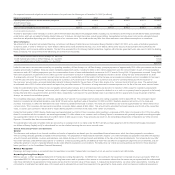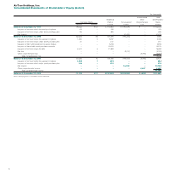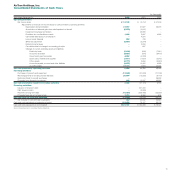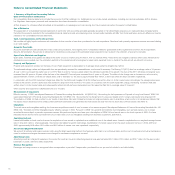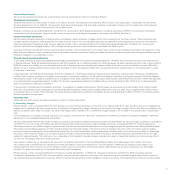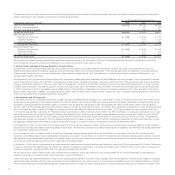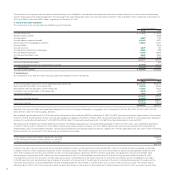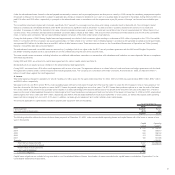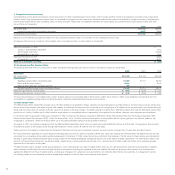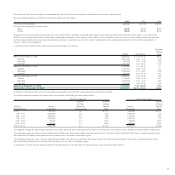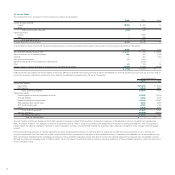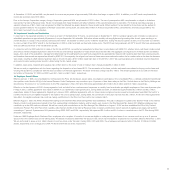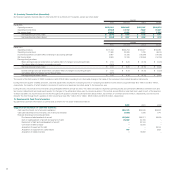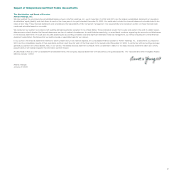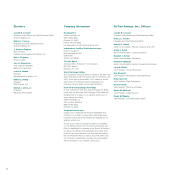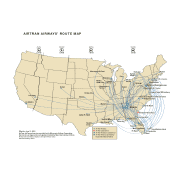Airtran 2002 Annual Report Download - page 40
Download and view the complete annual report
Please find page 40 of the 2002 Airtran annual report below. You can navigate through the pages in the report by either clicking on the pages listed below, or by using the keyword search tool below to find specific information within the annual report.
assets of, or any deposits with or other liabilities of such certificate holders. Additionally, if it becomes unlawful for such certificate holders to make or maintain the investment or credit
evidenced by the certificates, we have agreed to pay such certificate holders an amount necessary to cause the interest rate with respect to the certificates to be a rate per annum equal
to 4.88% over the rate specified by such certificate holders as the cost to them of obtaining funds in dollars in the United States in an amount equal to the pool balance of the certificates.
The maximum potential payment under these indemnities cannot be determined.
Airways’ aircraft lease transaction documents contain customary indemnities concerning withholding taxes under which we are responsible in some circumstances, should withholding
taxes be imposed, for paying such amounts of additional rent as is necessary to ensure that the lessor still receives, after taxes, the rent stipulated in the lease agreements. These
provisions apply on leases expiring through 2021. The maximum potential payment under these indemnities cannot be determined.
We have various leases with respect to real property, and various agreements among airlines relating to fuel consortia or fuel farms at airports, under which we have agreed to standard
language indemnifying the lessor against environmental liabilities associated with the real property covered under the agreement, even if we are not the party responsible for the environ-
mental damage. In the case of fuel consortia at the airports, these indemnities are generally joint and several among the airlines. We cannot quantify the maximum potential exposure
under these indemnities, and we do not currently have liability insurance that protects us against environmental damages.
Under certain contracts with third parties, we indemnify the third party against legal liability arising out of an action by a third party. The terms of these contracts vary and the potential
exposure under these indemnities cannot be determined. Generally, we have liability insurance protecting us from obligations undertaken under these indemnities.
From time to time, we are engaged in other litigation arising in the ordinary course of our business. We do not believe that any such pending litigation will have a material adverse effect
on our results of operations or financial condition.
During December 2002, we broke ground for a planned $14.5 million hangar facility at Hartsfield Atlanta International Airport. The 56,700 square-foot hangar will be large enough
to hold two of our B717 aircraft simultaneously and will also have a 20,000 square-foot, two-story office building attached to the hangar to house engineers and other support staff.
Completion of construction is expected by December 2003. The City of Atlanta is financing construction of the facility. Upon completion, we intend to consummate a long-term lease
agreement for the hangar facility.
5. Derivatives and Other Financial Instruments
Our results of operations can be significantly impacted by changes in the price and availability of aircraft fuel. Aircraft fuel expense, excluding special items, for 2002, 2001 and 2000
represented approximately 22.0 percent, 22.9 percent and 25.9 percent of our operating expenses, respectively.
Our efforts to reduce our exposure to increases in the price and availability of aviation fuel include the utilization of fixed-price fuel contracts and fuel cap contracts. Fixed-price fuel contracts
consist of an agreement to purchase defined quantities of aviation fuel from a third party at defined prices. Fuel cap contracts consist of an agreement to purchase defined quantities of
aviation fuel from a third party at a price not to exceed a defined price, limiting our exposure to upside market risk. Our fixed-price fuel contracts and fuel cap contracts are not required
to be accounted for as derivative financial instruments, in accordance with SFAS 133. As of December 31, 2002, utilizing fixed-price fuel contracts and fuel cap contracts we agreed to
purchase approximately 41 percent of our anticipated fuel needs through December 2003 at a price no higher than $0.74 per gallon of aviation fuel, including delivery to our operations
hub in Atlanta and other locations. During the first quarter of 2003, we entered into additional fuel cap contracts. These new contracts increased our total future fuel purchase commitments
to approximately 48 percent of our estimated fuel needs during 2003 at a price no higher than $0.77 per gallon of aviation fuel.
During 2001, we used swap agreements to hedge our fuel requirements. The fair value of our fuel-hedging agreements at December 31, 2001, representing the amount we would pay
upon termination of the agreements, totaled $8.7 million. The current portion of these contracts, $7.9 million, was recorded in “Accrued and other liabilities” while the long-term portion,
$0.8 million, was recorded in “Other liabilities” in our Consolidated Balance Sheets. We have accounted for our derivative instruments used to hedge fuel costs as cash flow hedges in
accordance with SFAS 133. Therefore, all changes in fair value that are considered to be effective are recorded in “Accumulated other comprehensive loss” until the underlying aircraft
fuel is consumed. During 2002 and 2001, we recognized losses of $6.0 million and $2.5 million, respectively, representing the effective portion of our hedging activities. These losses
are included in “Aircraft fuel” in the Consolidated Statement of Operations. We recognized gains of approximately $5.9 million and $2.2 million during 2002 and 2001, respectively,
representing the ineffectiveness of our hedging relationships. This gain is recorded in “SFAS 133 adjustment” in our Consolidated Statements of Operations.
Prior to the adoption of SFAS 133, these instruments were not recorded on the balance sheet. Because the fixed-price swap agreements and collar structures were considered highly
effective in offsetting changes in jet fuel prices, periodic settlements under the agreements were recognized as a component of fuel expense when the underlying fuel being hedged was
used. During 2000, we recognized gains of $5.1 million as a result of our hedging activities. These amounts are included in “Aircraft fuel” in our Consolidated Statements of Operations.
On November 28, 2001, the credit rating of the counterparty to all of our fuel-related hedges was downgraded and the counterparty declared bankruptcy on December 2, 2001. Due to the
deterioration of the counterparty’s creditworthiness, we no longer considered the financial contracts with the counterparty to be highly effective in offsetting our risk related to changing
fuel prices because of the consideration of the possibility that the counterparty would default by failing to make contractually required payments as scheduled in the derivative instrument.
As a result, on November 28, 2001, hedge accounting treatment was discontinued prospectively for our derivative contracts with this counterparty in accordance with SFAS 133. Gains
and losses previously deferred in “Accumulated other comprehensive loss” continue to be reclassified to earnings as the hedged item affects earnings. Beginning on November 28, 2001,
changes in fair value of the derivative instruments were marked to market through earnings. This resulted in a charge/(credit) of ($5.8) million and $0.2 million during 2002 and 2001,
respectively, which is included in the amount presented as “SFAS 133 adjustment” in our Consolidated Statements of Operations.
In March 2002, we terminated all our derivative agreements with the counterparty. The fair market value of the derivative liability on the termination date was approximately $0.5 million.
Since this was an early termination of our derivative contracts, losses of $6.8 million at December 31, 2001, deferred in other comprehensive loss will be reclassified to earnings as the
related fuel is used through September 2004. During 2002, we recognized approximately $6.0 million of the losses deferred in other comprehensive loss. Approximately $0.5 million in
net unrealized losses are expected to be realized in earnings during 2003. Upon the adoption of SFAS 133 on January 1, 2001, we recorded unrealized fuel hedge gains of $1.3 million,
of which $1.2 million was realized in earnings during 2001.
Financial instruments that potentially subject us to significant concentrations of credit risk consist principally of cash and cash equivalents and accounts receivable. We maintain cash
and cash equivalents with various high credit-quality financial institutions or in short-duration, high-quality debt securities. We periodically evaluate the relative credit standing of those
financial institutions that are considered in our investment strategy. Concentration of credit risk with respect to accounts receivable is limited, due to the large number of customers
comprising our customer base. The estimated fair value of other financial instruments, excluding debt described below, approximate their carrying amount.
19



